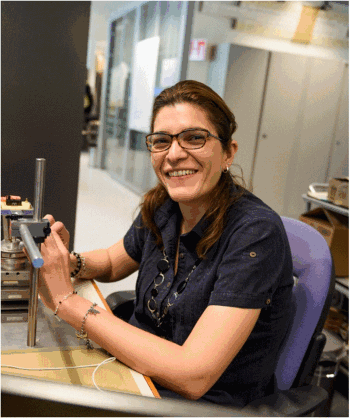A dependable anisotropic magnetoresistance sensor system for automotive applications
Andreina Zambrano Costantini is a PhD student in the Computer Architecture for Embedded Systems (CAES) group her supervisor is dr.ir. H.G. Kerkhoff from the Faculty Electrical Engineering, Mathematics and Computer Science
The increasing usage of electronic systems in automotive applications aims to enhance passenger safety as well as the performance of the cars. In modern vehicles mechanical and hydraulic systems traditionally used have been replaced by X-by-wire systems in which the functions are performed by electronic components. However, the components required should be reliable, have a high-performance, low-cost and capable of operating for a long time in a highly dependable manner despite the harsh operating conditions in automotive applications. Dependability represents the reliance that a user justifiably poses on the service offered by a system, being this especially important in safety-critical applications in which a failure can constitute a threat to people or the environment.
Magnetic sensors represent an excellent option to replace the wear-affected potentiometers which have been traditionally used. They offer several key advantages including mechanical robustness due to the non-contact measurement principle, extensive operating temperature range and low manufacturing cost. An Anisotropic Magnetoresistance (AMR) sensor is a type of magnetic sensor often used for angle measurements in applications such as steering or engine control which are considered to be safety-critical. The angle is obtained from two sinusoidal signals at the sensor outputs, which in theory should be perfect signals. However, in practice, they include undesired parameters such as offset voltage, amplitude imbalance and additional harmonics that affect the accuracy of the calculated angle and hence the performance of the sensor. Until now the offset voltage is the parameter mainly compensated for by calibration under factory conditions. Although the undesirable parameters drift over time, the sensor performance remains currently within the tolerance band permitted, and therefore aging compensation is usually not applied. However, this will change in the future because the tolerance band for drifting is expected to decrease as better performance of the sensor will be required over time, especially with the current trend of X-by-wire systems and autonomous cars.
In order to have a better understanding of the aging effects on AMR sensors because to the best of our knowledge there has been little published data on this issue, it was decided to perform a set of accelerated degradation tests. The results show that aging compensation will be required in the future, especially for the offset voltage that turns out to be the largest contributor to angle errors at the start of the sensor's life, but it also shows the most significant drift due to aging effects. In the second place the amplitude imbalance between the sinusoidal signals at the sensor outputs is causing angle errors and as last the harmonics.
Besides performance degradation, AMR sensors can also be affected by catastrophic faults that in principle cause the sensor to suddenly stop working. Therefore, the sensor dependability should be improved in order to guarantee that it will satisfy the continuous increasing dependability as well as accuracy requirements demanded by automotive applications. This research proposes an AMR sensor system that includes a fault-tolerant approach to handle catastrophic faults and self-X properties to maintain the performance of the sensor during its lifetime. Additionally, an interface with the IEEE 1687 standard has been considered, so the sensor is able to communicate with other components of the system in which it is integrated.
Self-X properties represent the capability of a system to perform certain functions on its own without any external help. In our system, self-monitoring of the maximum angle error is proposed to determine whether aging compensation is required in which case our self-calibration method allows updating the compensation factors for offset voltage as well as amplitude imbalance. Our fault-tolerant approach allows the sensor to continue operating although a catastrophic fault occurs in any of its magnetoresistances or the connections to the power supply or ground. All this is aimed to be executed online based on digital processing during the sensor lifetime. The system has been verified using data obtained from an analytical model of the sensor but also with data measured in commercial AMR sensors. The dependability assessment has been performed focussed on the dependability attributes, reliability, safety, maintainability and availability in order to verify the dependability improvement that can be obtained with the proposed system.
In conclusion, an AMR sensor system for angle measurements in automotive applications has been proposed which allows guaranteeing the correct service of the sensor despite unexpected failures or undesired aging effects. This is more than ever important with the current trend of reliance in electronic systems for the correct service of cars.
